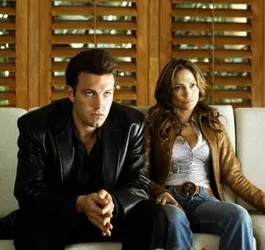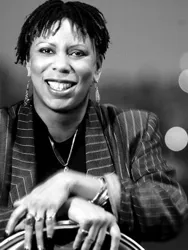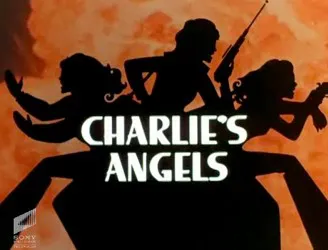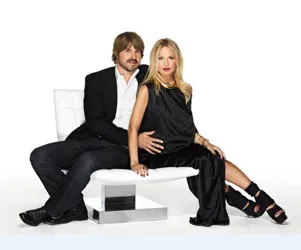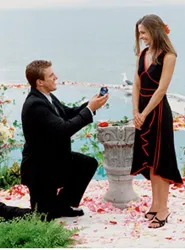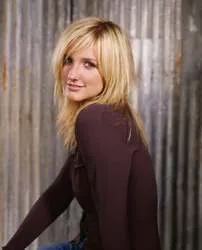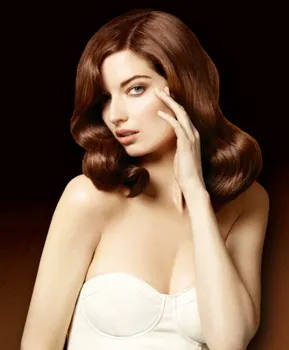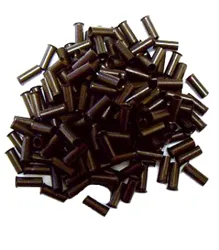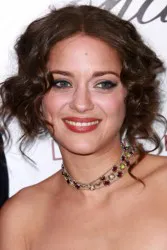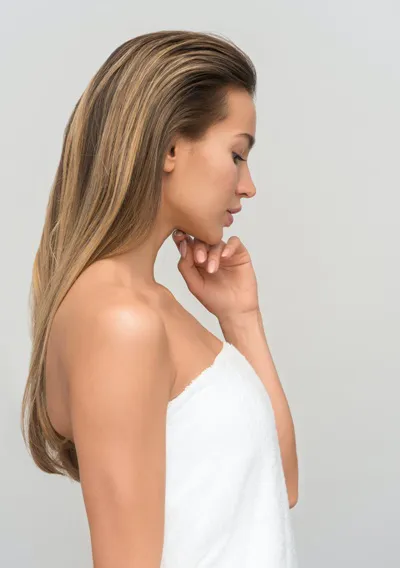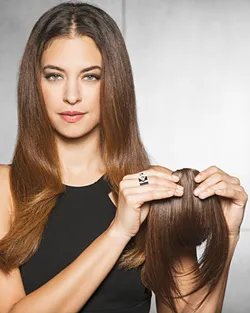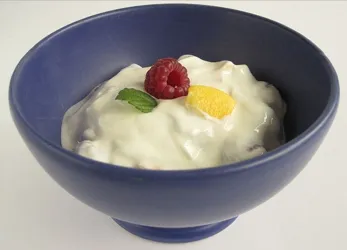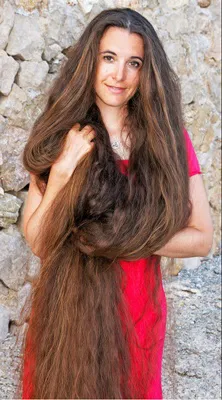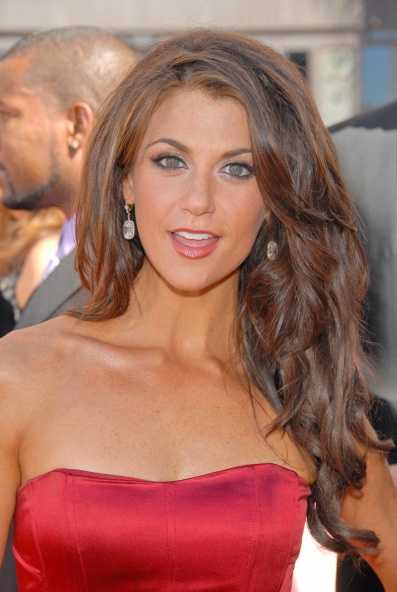Introduction 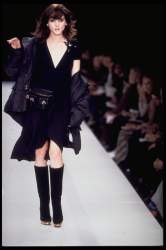 What trends are coming down the pipeline? They aren’t mainstream yet, but our sneak preview predicts undone dos, obvious color and styles that pick up the pieces. Photo to the side - courtesy of Clairol Professional Haircolor - Fall 2002 - all rights reserved) What trends are coming down the pipeline? They aren’t mainstream yet, but our sneak preview predicts undone dos, obvious color and styles that pick up the pieces. Photo to the side - courtesy of Clairol Professional Haircolor - Fall 2002 - all rights reserved)
Borrowing ideas and melding them into styles that show off self-expression continues to be the focus in Europe, as individualism meets late ‘70s and early ‘80s influences. What holds true as always: The current inspiration is almost always about 20 years back, reflecting fashion’s cyclical nature. But what’s truly new: Everyone has an interpretation of the looks, and to create theirs, they are deconstructing basic forms, shapes and styles. 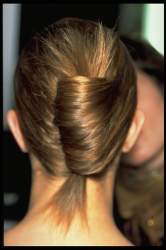 For instance, the long, clipped-up top of the ‘80s (which you usually created with a banana clip) now shows up pseudo-updos with pieces here and there that are spiraled and tucked up, or left to hang down as shown to the side. (Photo courtesy of Clairol Professional Haircolor - Fall 2002 - all rights reserved). For instance, the long, clipped-up top of the ‘80s (which you usually created with a banana clip) now shows up pseudo-updos with pieces here and there that are spiraled and tucked up, or left to hang down as shown to the side. (Photo courtesy of Clairol Professional Haircolor - Fall 2002 - all rights reserved).
Short, ‘80s clipper cuts are reinterpreted as highly textured looks that suit boys or girls equally. The tops are longer and the texture is broken up with products. While hair most often looks home-styled; it’s not home schooled—styles are still informed by the streets and fashion-capital trends. Elements of Style 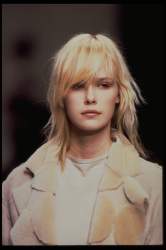 At Pivot Point International, which has beauty schools throughout Europe, stylists and professional educators say Crossover Cuts, which mix up traditional male and female cuts, allow flexibility and freshness in styles that aren’t that different at all. For example, short styles for both men and women can have a solid nape; alternating lengths in the crest and exterior; and irregular, shorter lengths at the crown. To feminize a cut, they add softer, wispy pieces near the face and at the fringe. (Photo courtesy of Clairol Professional Haircolor - Fall 2002 - all rights reserved) At Pivot Point International, which has beauty schools throughout Europe, stylists and professional educators say Crossover Cuts, which mix up traditional male and female cuts, allow flexibility and freshness in styles that aren’t that different at all. For example, short styles for both men and women can have a solid nape; alternating lengths in the crest and exterior; and irregular, shorter lengths at the crown. To feminize a cut, they add softer, wispy pieces near the face and at the fringe. (Photo courtesy of Clairol Professional Haircolor - Fall 2002 - all rights reserved)
Guys cuts are also getting lots longer and rounder, which reflects design elements of a traditional female cut. Women are even free to enjoy a lower, distinct hairline at the nape, which is part and parcel to a man’s cut. What’s fun is all that texture to play with! 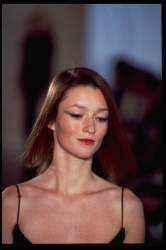 A simple trend anyone can adapt is the leaning toward side parts. In every fashion capital of the world, hair and long bangs are side-swept, because center parts simply look too ‘60s. A bonus of the trend: Side parts makes fine hair look thicker and hold its shape better. (Photo courtesy of Clairol Professional Haircolor - Fall 2002 - all rights reserved) A simple trend anyone can adapt is the leaning toward side parts. In every fashion capital of the world, hair and long bangs are side-swept, because center parts simply look too ‘60s. A bonus of the trend: Side parts makes fine hair look thicker and hold its shape better. (Photo courtesy of Clairol Professional Haircolor - Fall 2002 - all rights reserved)
Along with asymmetrical interest is a slew of bangs, which are most often long enough to tuck behind an ear. When bangs aren’t swept to the side, they are worn as a full fringe. After all, if hair is textured, piecy and broken up, strong bangs better balance the look. 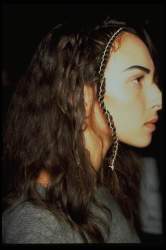 Whether on the streets or in salons, hair today is imperfect on purpose; ‘dos are UN-done. If you favor a simple ponytail, leave a few tendrils hanging free; when sporting a classic, tucked-back bob, let a few pieces swing forward to frame your face. While the style isn’t quite the “bedhead” of yesteryear, it does look a little like you did it yourself—but have great taste. (Photo courtesy of Clairol Professional Haircolor - Fall 2002 - all rights reserved) Whether on the streets or in salons, hair today is imperfect on purpose; ‘dos are UN-done. If you favor a simple ponytail, leave a few tendrils hanging free; when sporting a classic, tucked-back bob, let a few pieces swing forward to frame your face. While the style isn’t quite the “bedhead” of yesteryear, it does look a little like you did it yourself—but have great taste. (Photo courtesy of Clairol Professional Haircolor - Fall 2002 - all rights reserved)
Curls, waves and pulled-out pieces are all part of the slightly disheveled style, because it takes texture to get it. Rely on curling irons (used in strategic places), bobby pins (to hold up a few pieces) and new styling products to help you get your ‘do undone. Spectrum of Color 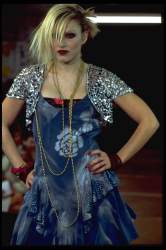 With all that movement in hair, it’s a given that haircolor goes both hot and cold in living color. No one shade dominates: beautiful brunettes, bold blondes and revved-up reds prove that full-spectrum color is where it’s at. There’s a warming trend with an added hint of red or gold highlights; solo-warm shades get cooler underneath. (Photo courtesy of Clairol Professional Haircolor - Fall 2002 - all rights reserved) With all that movement in hair, it’s a given that haircolor goes both hot and cold in living color. No one shade dominates: beautiful brunettes, bold blondes and revved-up reds prove that full-spectrum color is where it’s at. There’s a warming trend with an added hint of red or gold highlights; solo-warm shades get cooler underneath. (Photo courtesy of Clairol Professional Haircolor - Fall 2002 - all rights reserved)
But a bigger youth movement is toward bold, contrasting color blocks, created with triangular or even horseshoe partings. At Eric Fisher Salon in Wichita, KS, owner Eric Fisher says young people love the look and prefer the stark contrast of warms and cools. 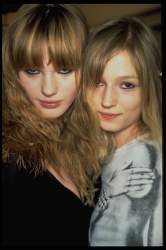 For instance, the entire surface is golden blonde, while all the underlayers are black. Or, cool brunette is bleached out at the ends and colored a cherry red. You can always tone down the shades and use the same color placement, says Fisher. ( For instance, the entire surface is golden blonde, while all the underlayers are black. Or, cool brunette is bleached out at the ends and colored a cherry red. You can always tone down the shades and use the same color placement, says Fisher. (
Photo courtesy of Clairol Professional Haircolor - Fall 2002 - all rights reserved) For instance, start with a golden brunette on the visible top and add a slightly deeper shade of brunette in wide panels that lie just under the surface. This color is convertible: wear it up and it looks darker; wear it down and it appears lighter. However, more sophisticated Europeans are opting for clear, sheer singular shades. 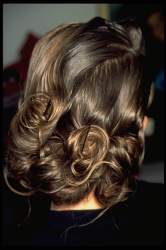 Another trend Fisher notes is the need for speed. Even teens are time-crunched today and to accommodate all busy clients, Fisher recently added an Express Menu of services, that includes quick color (he runs it in and out right at the shampoo bowl) and Tribal Updos, which are in keeping with the unkempt trend. To create them, Fisher simply pins up pieces here and there—sans shampoo and set. In under half-an-hour, you’ve got a great, new look. (Photo courtesy of Clairol Professional Haircolor - Fall 2002 - all rights reserved) Another trend Fisher notes is the need for speed. Even teens are time-crunched today and to accommodate all busy clients, Fisher recently added an Express Menu of services, that includes quick color (he runs it in and out right at the shampoo bowl) and Tribal Updos, which are in keeping with the unkempt trend. To create them, Fisher simply pins up pieces here and there—sans shampoo and set. In under half-an-hour, you’ve got a great, new look. (Photo courtesy of Clairol Professional Haircolor - Fall 2002 - all rights reserved)
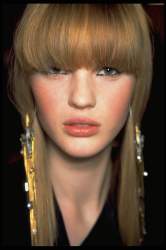 For those who just aren’t brave enough for bold chunks of color or monochromatic shades, perfection-placement highlights (or lowlights) make the most of a cut. For those who just aren’t brave enough for bold chunks of color or monochromatic shades, perfection-placement highlights (or lowlights) make the most of a cut.
By positioning narrow or wider than normal highlights right near the face or around the halo of the head, colorists can enhance a specific aspect of a cut or put the focus on your face. Sometimes, highlights only go half-way down the strand. (Photo courtesy of Clairol Professional Haircolor - Fall 2002 - all rights reserved) 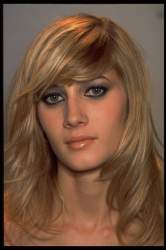 Fisher creates quick “Flashings” by adding large triangular sections around the head; at the Salon, Hair Color By Design in Waldorf, MD, JoAnne Kohut creates “Splushing” color by adding 6 to 8 foils of color around the halo of the head, bleaching the center area and “feathering” on color above and below the decolorized area to blend it to the natural color. (Photo courtesy of Clairol Professional Haircolor - Fall 2002 - all rights reserved) Fisher creates quick “Flashings” by adding large triangular sections around the head; at the Salon, Hair Color By Design in Waldorf, MD, JoAnne Kohut creates “Splushing” color by adding 6 to 8 foils of color around the halo of the head, bleaching the center area and “feathering” on color above and below the decolorized area to blend it to the natural color. (Photo courtesy of Clairol Professional Haircolor - Fall 2002 - all rights reserved)
For men or women with a short, textured cut, Tony Anders of Kenneth’s Hair Design in Columbus, OH, creates an American interpretation: a “Statue of Liberty” effect. He does it by teasing small pieces into spikes and tipping the ends with a lighter-than-natural color or a strong lightener. It’s all about customizing the color to the cut and the individual. Dramatic Touches 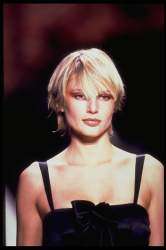 Back on the dramatic side, another continuing trend is the undercut look, which came from Europe and is going mainstream State-side. Hair below the temples is cut short and close, then longer hair falls over the top. Conceal the undercut or not by wearing hair up, down or tucked back. This is a variation of a look seen in clubs in the ‘80s, when mostly men had hair undercut very close—even above the temples—but left hair very long just above the temples and through most the back. Today, how much you undercut and how close you cut it is up to you. Back on the dramatic side, another continuing trend is the undercut look, which came from Europe and is going mainstream State-side. Hair below the temples is cut short and close, then longer hair falls over the top. Conceal the undercut or not by wearing hair up, down or tucked back. This is a variation of a look seen in clubs in the ‘80s, when mostly men had hair undercut very close—even above the temples—but left hair very long just above the temples and through most the back. Today, how much you undercut and how close you cut it is up to you.
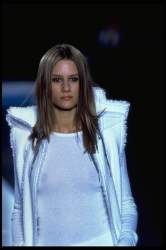 Finally, since the ‘60s influence is over, say goodbye to geometric cuts. Today, ends are anything but blunt. Choppy, jagged and ragged endings all enhance disheveled ‘dos and make imprecise styling easier than ever. Pull a piece up or tuck it back, no matter. Finally, since the ‘60s influence is over, say goodbye to geometric cuts. Today, ends are anything but blunt. Choppy, jagged and ragged endings all enhance disheveled ‘dos and make imprecise styling easier than ever. Pull a piece up or tuck it back, no matter.
Cuts allow that mussed-up feeling, even when you comb your hair straight down. And since irregular pieces are snipped to lengths that accent eyes, lips or cheekbones (but can be styled any way you like), you can get a look that’s either more or less controlled by simply moving the pieces around. Aren’t ready for a big change? Not to worry. If Europeans area right, in a few years you’ll be wearing classic cuts and monochromatic styles, naturally, made your own with texturizing. | 


 What trends are coming down the pipeline? They aren’t mainstream yet, but our sneak preview predicts undone dos, obvious color and styles that pick up the pieces. Photo to the side - courtesy of Clairol Professional Haircolor - Fall 2002 - all rights reserved)
What trends are coming down the pipeline? They aren’t mainstream yet, but our sneak preview predicts undone dos, obvious color and styles that pick up the pieces. Photo to the side - courtesy of Clairol Professional Haircolor - Fall 2002 - all rights reserved)  For instance, the long, clipped-up top of the ‘80s (which you usually created with a banana clip) now shows up pseudo-updos with pieces here and there that are spiraled and tucked up, or left to hang down as shown to the side. (Photo courtesy of Clairol Professional Haircolor - Fall 2002 - all rights reserved).
For instance, the long, clipped-up top of the ‘80s (which you usually created with a banana clip) now shows up pseudo-updos with pieces here and there that are spiraled and tucked up, or left to hang down as shown to the side. (Photo courtesy of Clairol Professional Haircolor - Fall 2002 - all rights reserved). At Pivot Point International, which has beauty schools throughout Europe, stylists and professional educators say Crossover Cuts, which mix up traditional male and female cuts, allow flexibility and freshness in styles that aren’t that different at all. For example, short styles for both men and women can have a solid nape; alternating lengths in the crest and exterior; and irregular, shorter lengths at the crown. To feminize a cut, they add softer, wispy pieces near the face and at the fringe. (Photo courtesy of Clairol Professional Haircolor - Fall 2002 - all rights reserved)
At Pivot Point International, which has beauty schools throughout Europe, stylists and professional educators say Crossover Cuts, which mix up traditional male and female cuts, allow flexibility and freshness in styles that aren’t that different at all. For example, short styles for both men and women can have a solid nape; alternating lengths in the crest and exterior; and irregular, shorter lengths at the crown. To feminize a cut, they add softer, wispy pieces near the face and at the fringe. (Photo courtesy of Clairol Professional Haircolor - Fall 2002 - all rights reserved) A simple trend anyone can adapt is the leaning toward side parts. In every fashion capital of the world, hair and long bangs are side-swept, because center parts simply look too ‘60s. A bonus of the trend: Side parts makes fine hair look thicker and hold its shape better. (Photo courtesy of Clairol Professional Haircolor - Fall 2002 - all rights reserved)
A simple trend anyone can adapt is the leaning toward side parts. In every fashion capital of the world, hair and long bangs are side-swept, because center parts simply look too ‘60s. A bonus of the trend: Side parts makes fine hair look thicker and hold its shape better. (Photo courtesy of Clairol Professional Haircolor - Fall 2002 - all rights reserved) Whether on the streets or in salons, hair today is imperfect on purpose; ‘dos are UN-done. If you favor a simple ponytail, leave a few tendrils hanging free; when sporting a classic, tucked-back bob, let a few pieces swing forward to frame your face. While the style isn’t quite the “bedhead” of yesteryear, it does look a little like you did it yourself—but have great taste. (Photo courtesy of Clairol Professional Haircolor - Fall 2002 - all rights reserved)
Whether on the streets or in salons, hair today is imperfect on purpose; ‘dos are UN-done. If you favor a simple ponytail, leave a few tendrils hanging free; when sporting a classic, tucked-back bob, let a few pieces swing forward to frame your face. While the style isn’t quite the “bedhead” of yesteryear, it does look a little like you did it yourself—but have great taste. (Photo courtesy of Clairol Professional Haircolor - Fall 2002 - all rights reserved) With all that movement in hair, it’s a given that haircolor goes both hot and cold in living color. No one shade dominates: beautiful brunettes, bold blondes and revved-up reds prove that full-spectrum color is where it’s at. There’s a warming trend with an added hint of red or gold highlights; solo-warm shades get cooler underneath. (Photo courtesy of Clairol Professional Haircolor - Fall 2002 - all rights reserved)
With all that movement in hair, it’s a given that haircolor goes both hot and cold in living color. No one shade dominates: beautiful brunettes, bold blondes and revved-up reds prove that full-spectrum color is where it’s at. There’s a warming trend with an added hint of red or gold highlights; solo-warm shades get cooler underneath. (Photo courtesy of Clairol Professional Haircolor - Fall 2002 - all rights reserved) For instance, the entire surface is golden blonde, while all the underlayers are black. Or, cool brunette is bleached out at the ends and colored a cherry red. You can always tone down the shades and use the same color placement, says Fisher. (
For instance, the entire surface is golden blonde, while all the underlayers are black. Or, cool brunette is bleached out at the ends and colored a cherry red. You can always tone down the shades and use the same color placement, says Fisher. ( Another trend Fisher notes is the need for speed. Even teens are time-crunched today and to accommodate all busy clients, Fisher recently added an Express Menu of services, that includes quick color (he runs it in and out right at the shampoo bowl) and Tribal Updos, which are in keeping with the unkempt trend. To create them, Fisher simply pins up pieces here and there—sans shampoo and set. In under half-an-hour, you’ve got a great, new look. (Photo courtesy of Clairol Professional Haircolor - Fall 2002 - all rights reserved)
Another trend Fisher notes is the need for speed. Even teens are time-crunched today and to accommodate all busy clients, Fisher recently added an Express Menu of services, that includes quick color (he runs it in and out right at the shampoo bowl) and Tribal Updos, which are in keeping with the unkempt trend. To create them, Fisher simply pins up pieces here and there—sans shampoo and set. In under half-an-hour, you’ve got a great, new look. (Photo courtesy of Clairol Professional Haircolor - Fall 2002 - all rights reserved) For those who just aren’t brave enough for bold chunks of color or monochromatic shades, perfection-placement highlights (or lowlights) make the most of a cut.
For those who just aren’t brave enough for bold chunks of color or monochromatic shades, perfection-placement highlights (or lowlights) make the most of a cut.  Fisher creates quick “Flashings” by adding large triangular sections around the head; at the Salon, Hair Color By Design in Waldorf, MD, JoAnne Kohut creates “Splushing” color by adding 6 to 8 foils of color around the halo of the head, bleaching the center area and “feathering” on color above and below the decolorized area to blend it to the natural color. (Photo courtesy of Clairol Professional Haircolor - Fall 2002 - all rights reserved)
Fisher creates quick “Flashings” by adding large triangular sections around the head; at the Salon, Hair Color By Design in Waldorf, MD, JoAnne Kohut creates “Splushing” color by adding 6 to 8 foils of color around the halo of the head, bleaching the center area and “feathering” on color above and below the decolorized area to blend it to the natural color. (Photo courtesy of Clairol Professional Haircolor - Fall 2002 - all rights reserved) Back on the dramatic side, another continuing trend is the undercut look, which came from Europe and is going mainstream State-side. Hair below the temples is cut short and close, then longer hair falls over the top. Conceal the undercut or not by wearing hair up, down or tucked back. This is a variation of a look seen in clubs in the ‘80s, when mostly men had hair undercut very close—even above the temples—but left hair very long just above the temples and through most the back. Today, how much you undercut and how close you cut it is up to you.
Back on the dramatic side, another continuing trend is the undercut look, which came from Europe and is going mainstream State-side. Hair below the temples is cut short and close, then longer hair falls over the top. Conceal the undercut or not by wearing hair up, down or tucked back. This is a variation of a look seen in clubs in the ‘80s, when mostly men had hair undercut very close—even above the temples—but left hair very long just above the temples and through most the back. Today, how much you undercut and how close you cut it is up to you.  Finally, since the ‘60s influence is over, say goodbye to geometric cuts. Today, ends are anything but blunt. Choppy, jagged and ragged endings all enhance disheveled ‘dos and make imprecise styling easier than ever. Pull a piece up or tuck it back, no matter.
Finally, since the ‘60s influence is over, say goodbye to geometric cuts. Today, ends are anything but blunt. Choppy, jagged and ragged endings all enhance disheveled ‘dos and make imprecise styling easier than ever. Pull a piece up or tuck it back, no matter. 